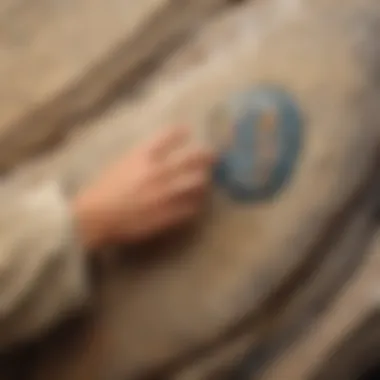Enhance Your Outdoor Decor: Tips for Choosing the Best Paint for Outdoor Rocks


Fun Activities Ideas
When it comes to outdoor rock painting projects, selecting the right type of paint is crucial to ensure longevity and visual appeal. Choosing the correct paint can enhance the aesthetics of your painted rocks while also protecting them from the elements. The process of selecting paint for outdoor rock painting involves considering factors like durability, weather resistance, and adherence to the rock surface. By following a few key guidelines, you can elevate your outdoor decor through creatively painted rocks that stand the test of time.
To begin with, acrylic paints are a popular choice for outdoor rock painting due to their versatility and durability. These paints adhere well to rock surfaces, resist fading from UV exposure, and offer a wide range of colors for creative expression. Additionally, waterproof sealants can be applied over acrylic paints to provide added protection against water damage and ensure the longevity of your painted rocks. When selecting acrylic paints for outdoor rock painting, opt for high-quality brands that are specifically formulated for outdoor use to achieve the best results.
Another important consideration when choosing paint for outdoor rocks is the finish of the paint. Matte finishes provide a subtle and natural look to painted rocks, while glossy finishes offer a shiny and vibrant appearance. The choice of finish largely depends on your aesthetic preference and the overall look you want to achieve. Experimenting with different finishes can add variety and visual interest to your painted rock collection, allowing you to create unique and personalized outdoor decor. Remember to apply a clear sealant over the paint to protect the finish and enhance the colors of your painted rocks.
Introduction
In the realm of outdoor rock painting, the choice of paint holds immense significance. The artistry and durability of painted rocks depend inherently on the type of paint selected for the project. It goes beyond mere aesthetics and delves into the critical aspects of longevity, weather resistance, and overall visual appeal. To unleash the full potential of outdoor rock painting, understanding the nuances of paint selection becomes paramount in achieving lasting and visually captivating results.
Understanding the Importance of Paint Selection
When contemplating outdoor rock painting, it is crucial to grasp the impact of paint selection on the overall project. Factors such as the type of paint, application methods, and environmental considerations come into play. The paint chosen not only determines the vibrancy of colors but also influences the rock's ability to withstand external elements. By selecting the appropriate paint, enthusiasts can ensure their painted rocks remain vibrant and intact for a prolonged period.
Sub factors impacting outdoor rock painting include paint durability, adhesion to various rock textures, and resistance to weather elements. The choice of paint can dictate how well the artwork stands the test of time against sun exposure, rain, and temperature changes. Opting for paints specifically formulated for outdoor use can offer enhanced protection and longevity to painted rocks, making them ideal for exterior decor projects.
Benefits of Using the Right Paint
The benefits of using the right paint for outdoor rock projects are multifold, with enhanced durability being a prominent advantage. Paints designed for outdoor applications are formulated to provide longevity and resilience against environmental factors. This durability ensures that painted rocks maintain their vibrancy and charm despite prolonged exposure to the elements.
Furthermore, weather resistance is a key benefit of selecting the right paint. Paints that can withstand sun exposure, moisture, and temperature variations play a vital role in preserving the artwork's integrity. By choosing paints with excellent weather resistance properties, outdoor rock painters can enjoy their creations for years to come.
Aesthetic appeal is another significant advantage of using the right paint. The color options, finishes, and compatibility with rock textures offered by high-quality paints enable artists to unleash their creativity and achieve visually stunning effects. The right paint can elevate the overall aesthetics of painted rocks, transforming them into captivating outdoor decor pieces.
Types of Paint for Outdoor Rocks
When it comes to outdoor rock painting, selecting the right type of paint is crucial for achieving lasting results. The choice of paint can impact factors such as durability, weather resistance, and overall aesthetic appeal of the finished artwork. Different types of paint offer varying benefits and considerations that cater to the specific needs of rock painting projects. Understanding the characteristics and suitability of acrylic paint, outdoor craft paint, spray paint, and paint pens can help you make an informed decision based on your requirements and preferences.
Acrylic Paint
Acrylic paint is a popular choice for outdoor rock painting due to its versatility in colors. The wide range of hues available allows for vibrant designs and intricate detailing on rocks. One of the key characteristics of acrylic paint is its quick drying time, which enables artists to work efficiently and layer colors without extended wait times. This quick-drying nature is beneficial for projects that require multiple layers or intricate designs. Acrylic paint is also suitable for beginners, as it is easy to use and provides a smooth application experience, making it ideal for those new to rock painting.


Outdoor Craft Paint
Specifically formulated for outdoor use, outdoor craft paint offers long-lasting color protection for painted rocks. The formulation of this type of paint ensures that colors remain vibrant even when exposed to various weather conditions. Additionally, outdoor craft paint is available in various finishes, such as glossy, matte, or textured, providing artists with options to achieve their desired look. The diversity in finishes adds depth and visual appeal to painted rocks, enhancing their overall aesthetic.
Spray Paint
Spray paint provides a convenient application method for outdoor rock painting. The aerosol format allows for quick and even coverage of rocks, ensuring a smooth and consistent finish. The durable nature of spray paint results in a long-lasting coat that withstands outdoor elements. However, spray paint requires precise handling during application to prevent overspray or uneven coverage, making it essential to use in well-ventilated areas and with caution.
Paint Pens
Paint pens are great for creating intricate designs on rocks due to their fine tips and precise application. The pens offer excellent control, allowing artists to draw detailed patterns or write messages with ease. While paint pens are easy to use, they may require additional sealant to protect the artwork from fading or smudging over time. The added sealant ensures the longevity of the painted designs, making them suitable for outdoor display.
Factors to Consider When Choosing Paint
In the realm of outdoor rock painting, the choice of paint holds significant importance as it directly impacts the longevity and visual appeal of the finished project. When considering the ideal paint for outdoor rocks, several key factors come into play to ensure a successful and enduring outcome. Factors such as durability, weather resistance, and aesthetic appeal play a crucial role in determining the suitability of the paint for this specific application.
Durability
When delving into the realm of paint selection for outdoor rocks, durability stands out as a paramount factor to consider. The ability of the paint to withstand various elements and external stressors is essential for ensuring the longevity of the artwork. Factors such as resistance to fading, protection against weather elements, and the longevity of color vibrancy are key elements that contribute to the overall durability of the painted rocks.
Resistance to Fading
Resistance to fading is a critical aspect to consider when choosing paint for outdoor rocks. Paints that offer high resistance to fading can maintain the vibrancy of colors even when exposed to harsh sunlight and other environmental factors. This characteristic ensures that the painted rocks retain their visual appeal over an extended period, making them a popular choice among outdoor rock painting enthusiasts.
Protection Against Weather Elements
Protection against weather elements is another vital feature to look for in paint meant for outdoor rock projects. A paint that provides effective protection against rain, moisture, UV rays, and temperature fluctuations helps safeguard the painted surface from potential damage and ensures the longevity of the artwork. This feature contributes significantly to maintaining the integrity of the painted rocks in various outdoor conditions.
Longevity of Color Vibrancy
The longevity of color vibrancy is a key consideration when selecting paint for outdoor rocks. Paints that can retain their color intensity and vibrancy over time without fading or dulling ensure that the artwork remains visually striking and attractive. Opting for paints known for their strong color retention properties enhances the overall appeal and longevity of the painted rocks, making them a popular choice for outdoor projects.
Weather Resistance


Apart from durability, weather resistance plays a crucial role in determining the effectiveness of paint for outdoor rock painting. The paint's ability to withstand sun exposure, resist rain and moisture, as well as tolerate temperature changes are essential factors to consider when aiming for long-lasting and visually appealing results.
Ability to Withstand Sun Exposure
The paint's ability to withstand sun exposure is an important consideration for outdoor rock projects. Paints that are UV resistant and do not easily fade under direct sunlight ensure that the artwork maintains its vivid colors and overall visual appeal even when exposed to intense sunlight. Opting for paints with high sun resistance properties is essential for preserving the quality of the painted rocks.
Resistance to Rain and Moisture
Another vital aspect of weather resistance is the paint's ability to resist rain and moisture. Paint formulations that offer water resistance protect the painted rocks from damage caused by rain, humidity, or water exposure. Selecting paints with superior moisture resistance properties ensures that the artwork remains intact and visually appealing despite wet conditions.
Tolerance to Temperature Changes
The paint's tolerance to temperature changes is crucial for outdoor rock painting endeavors. Paints that can withstand fluctuations in temperature without cracking, peeling, or compromising their color integrity are ideal for maintaining the longevity and visual aesthetics of the painted rocks. Opting for paints known for their temperature resilience guarantees that the artwork remains intact and retains its original allure under varying climatic conditions.
Aesthetic Appeal
Beyond durability and weather resistance, the aesthetic appeal of the paint plays a significant role in the overall success of outdoor rock painting projects. Factors such as color options and combinations, compatibility with rock textures, and the ability to achieve desired artistic effects contribute to creating visually captivating and aesthetically pleasing artworks.
Color Options and Combinations
When choosing paint for outdoor rocks, the availability of diverse color options and the compatibility of different color combinations are essential considerations. Paints that offer a wide range of hues and shades allow artists to unleash their creativity and design visually appealing patterns and artwork on the rocks. Opting for paints with versatile color options and the ability to mix and match various shades enhances the artistic possibilities and aesthetic appeal of the finished pieces.
Compatibility with Rock Textures
The paint's compatibility with different rock textures is crucial for achieving optimal results in outdoor rock painting. Paint formulations that adhere well to various rock surfaces and textures ensure smooth application and a consistent finish across different types of rocks. Choosing paints specifically designed to bond effectively with rocky surfaces facilitates the creation of detailed and intricate artwork, enhancing the overall visual appeal of the painted rocks.
Ability to Achieve Desired Effects
The paint's ability to help artists achieve their desired artistic effects is a key factor to consider when selecting paint for outdoor rock projects. Paints that offer precise control, easy blending, and the capability to create intricate designs enable artists to bring their creative visions to life effectively. Opting for paints that allow for the desired effects, such as gradients, fine lines, or detailed patterns, empowers artists to produce high-quality and visually striking artwork on outdoor rocks, elevating the aesthetic appeal of the final pieces.
Application and Sealing Techniques
When it comes to outdoor rock painting, mastering the application and sealing techniques is crucial to ensure the longevity and vibrancy of your artwork. Properly applying paint and sealing the finished piece can allow your creation to withstand the harsh outdoor elements and preserve its aesthetic appeal over time. One of the key elements of this process is the thorough prepping of the rocks before painting and sealing.


Prepping the Rocks
Cleaning and Drying Process
The cleaning and drying process is not to be underestimated in the realm of outdoor rock painting. By meticulously cleaning the rocks and allowing them to fully dry, you create a clean and dry surface for the paint to adhere to. This step is essential for ensuring the paint stays put and resists peeling or flaking over time. An advantage of this meticulous cleaning process is that it prevents dust or debris from interfering with the paint adhesion, resulting in a smoother application and a more polished final look.
Priming for Better Adhesion
Priming the rocks for better adhesion serves as a fundamental preparatory step in the application process. By priming the rocks, you create a stable base for the paint to adhere to, enhancing its longevity and vibrancy. The key characteristic of priming for better adhesion lies in its ability to create a uniform surface that promotes better paint adhesion and prevents the colors from appearing differently due to variations in the rock's texture. This unique feature of priming ensures that your painted rocks maintain a consistent and professional finish, elevating the overall quality of your outdoor rock artwork.
Painting Process
Applying Base Coats
Applying base coats is a crucial step in the painting process that sets the foundation for your masterpiece. Base coats provide a solid color base that allows the subsequent layers of paint to adhere better and appear more vibrant. The key characteristic of applying base coats is their ability to create a smooth and even surface, ensuring that the colors pop and blend seamlessly. This technique is a popular choice for outdoor rock painting as it helps achieve a professional and polished final result.
Layering Colors and Designs
Layering colors and designs adds depth and complexity to your outdoor rock artwork, transforming simple rocks into intricate masterpieces. This technique allows you to experiment with different colors, patterns, and textures, creating visually appealing designs that stand out. The key characteristic of layering colors and designs is the creative freedom it offers, enabling you to explore various artistic possibilities and express your unique style. By layering colors and designs, you can bring your outdoor rock paintings to life and make them visually engaging and captivating.
Sealing the Finished Artwork
Protective Sealants and Varnishes
Protective sealants and varnishes play a vital role in preserving the longevity and durability of your outdoor rock paintings. By applying a protective sealant or varnish, you create a barrier that shields the paint from external elements such as UV rays, moisture, and general wear and tear. The key characteristic of protective sealants and varnishes is their ability to enhance the colors, protect the artwork from fading or chipping, and prolong its lifespan. This sealing technique is a popular choice among outdoor rock artists for its effectiveness in maintaining the integrity and beauty of the artwork.
Enhancing Longevity and Durability
Enhancing the longevity and durability of your outdoor rock paintings is essential for ensuring their lasting beauty. By using sealants and varnishes specifically designed for outdoor use, you can protect your artwork from damage caused by sun exposure, moisture, and other environmental factors. The key characteristic of enhancing longevity and durability is the added layer of protection it provides, prolonging the life of your outdoor rock paintings and keeping them looking fresh and vibrant for years to come. This technique is highly beneficial for outdoor rock artists who seek to showcase their creations in various weather conditions while maintaining their visual appeal.
Conclusion
In the realm of outdoor rock painting, the choice of paint holds paramount importance in ensuring the longevity and visual appeal of artistic creations. Selecting the right type of paint for outdoor rocks goes beyond mere aesthetics and delves into factors like durability, weather resistance, and overall quality. By carefully considering these elements, rock painters can elevate their projects from mundane to exceptional. The proper selection of paint not only enhances the beauty of the painted rocks but also ensures that the artwork withstands the harsh outdoor elements, such as UV exposure, moisture, and temperature changes, standing the test of time.
Final Thoughts on Paint Selection
Choosing the best paint for your outdoor rock projects
When it comes to choosing the best paint for outdoor rock projects, one must pay close attention to factors like durability, color vibrancy, and compatibility with different rock textures. Opting for paints that offer enhanced weather resistance and protection against fading is essential for long-lasting artwork. Among the various options available, paints that provide a balance between aesthetics and performance are highly recommended. Choosing the best paint for outdoor rock projects involves considering the specific needs of the artwork and the environmental conditions the rocks will be exposed to. By selecting paints that exhibit superior adhesion properties and vibrant color payoff, artists can ensure that their outdoor rock creations remain striking and intact despite external challenges. The careful selection of paint is a critical step in ensuring the success and longevity of outdoor rock painting endeavors.



